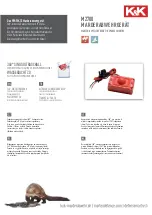
Chapter 2
Installation and Configuration
©
National Instruments Corporation
2-7
•
Quick Boot Mode
—When you enable this option, certain lengthy
BIOS tests that rarely fail are skipped to shorten controller boot time.
The default is
Enabled
.
•
Summary Screen
—This setting controls the display of the summary
screen shown after BIOS completes its initialization, but before
booting takes place. You can disable this screen in the interest of
shortening controller boot time. The default is
Disabled
.
•
PXE Network Boot
—This setting enables the option for booting from
a network PXE server on the subnet. The default is
Disabled
.
Note
You must set the
Boot Configuration
option on the
LabVIEW RT
menu to either
boot
Windows/Other OS
or
Use Hardware Switch
, with all the LabVIEW RT switches
set to the OFF position, in order to enable PXE Network boot.
•
Write Protect Boot Sector
—When set to
Yes
, this setting prevents
modification of a hard disk boot sector via INT 13h services, which
may help prevent certain computer viruses from infecting the
controller. This setting does not prevent boot sector modification
by 32-bit operating system drivers that access the hard disk directly.
The default is
No
.
Integrated Peripherals Submenu
Use this submenu to apply nondefault configurations to the front panel
peripherals of an NI PXI-8195/8196 controller. Normally, you do not need
to modify these settings, as the factory default settings provide the most
compatible and optimal configuration possible.
•
Serial Port A
—This setting enables or disables COM1. You also can
change this setting to
Enabled
and modify the base address and
Interrupt Request Level (IRQ) of a port. The default is
Auto
, which
places COM1 at 0x3F8 IRQ 4.
•
Parallel Port
—Use this setting to enable or disable LPT1. You also
can change this setting to
Enabled
and modify the base address,
IRQ level, and ISA Direct Memory Access (DMA) channel of the
port. The default is
Auto
, which places LPT1 at 0x378, IRQ 7, using
ISA DMA Channel 3 if necessary.
•
Parallel Port Mode
—The PC industry has created several different
modes of operation for this port over the years. Usually, the default
setting works for all applications. However, if a parallel port device
specifically requires a nondefault setting, you can change it here.
The default is
Bidirectional
, for full IEEE 1284 capabilities.
















































